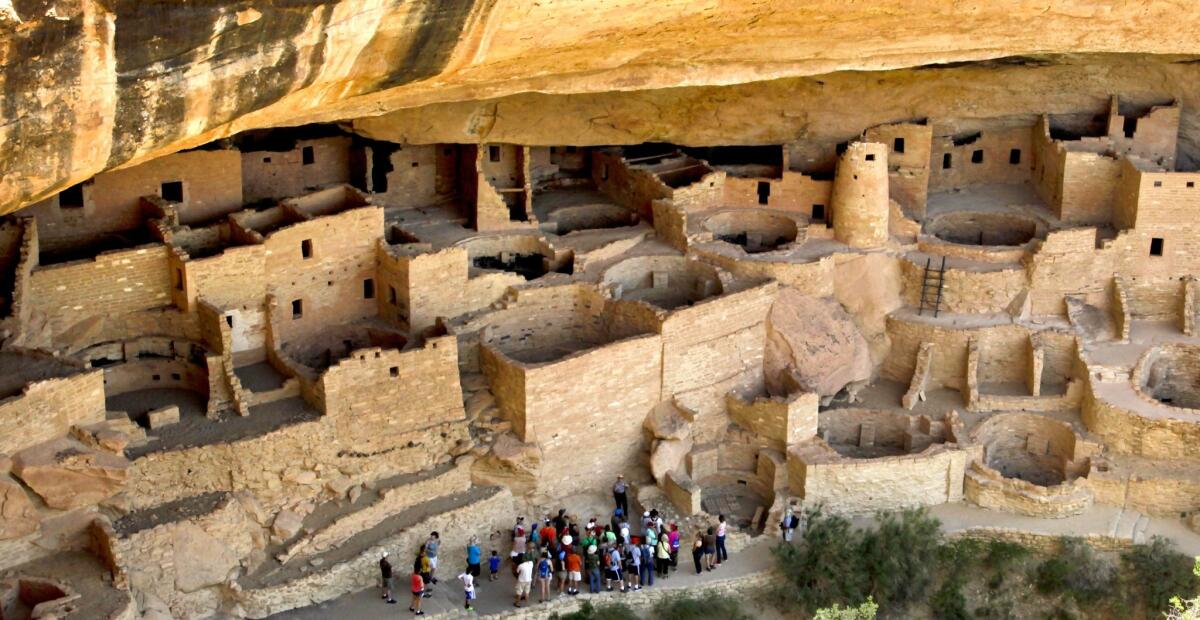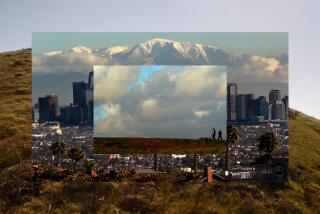At Mesa Verde National Park, step back into ancient Pueblo times

- Share via
Reporting from Durango, Colo. — It’s a 90-minute drive from Durango, Colo., to Mesa Verde National Park. Do it — especially if it’s summer, when you’ll have a chance to climb among the park’s cliff dwellings.
After all, you probably won’t be in this thinly populated western Colorado neighborhood again soon. This remote location is why, even in busy July, the park tops out at about 3,000 travelers a day — about one-eighth the traffic seen at the Grand Canyon.
But Mesa Verde’s main attractions — more than 600 cliff dwellings, many dating to the 13th century — are a sight that won’t leave you any time soon. In fact, you may be too busy feeling like Indiana Jones to hear the ranger tell you that this was the first U.S. national park (1906) devoted to cultural history — something made by mankind — rather than natural history.
Then again, if you’re afraid of heights or tight spaces, some spots will be downright alarming.
The park is full of ruins, trails and austere scenery, including the Long House and Step House on Wetherill Mesa, as well as Chapin Mesa Archeological Museum, which tells how the Ancestral Puebloans (also known as Anasazi) lived and farmed on mesa tops for hundreds of years before moving to the cliff dwellings below, then moving on to New Mexico and Arizona in about 1300.
If you’re fairly fit and untroubled by heights, I recommend the Cliff Palace and Balcony House tours, which are led by rangers in warmer months. To reach those cliff dwellings, you drive 21 miles from the northern entrance to the center of the park, crossing stark territory (7,000 to 8,500 feet above sea level) whose pinyon and juniper forests have been repeatedly scarred by fire. Between 1996 and 2003, five fires, all sparked by lightning, together burned more than half the park’s 52,000 acres.
Just about the time you start wondering why you came so far to see such a bleak scene, you’ll arrive at the heart of Mesa Verde, leave your car in a lot and step down from the top of the mesa into the late 1200s.
Cliff Palace is the park’s largest cliff dwelling, with 150 rooms and 23 kivas (rooms used for religious rituals). It’s thought to have housed about 100 Ancestral Puebloans.. The structures are made of sandstone blocks, mortar, plaster and wood beams.
Though the quarter-mile path includes more than 100 stair steps, four ladders of 8 to 10 feet each and plenty of steep drops without railings, it’s less physically demanding than some others. If you’re not up to the tour, go to the outcropping of rock where groups meet before descending, and you’ll find a breathtaking view of Cliff Palace under the lip of a sandstone ridge.
Balcony House is a wonder too: Forty rooms hanging above Soda Canyon. To walk among the ruins, you’ll need to descend a 100-foot staircase, ascend a 32-foot ladder, crawl through a 12-foot-long tunnel that’s about 18 inches wide, then climb on about 60 feet of ladders and steep steps that are carved into the rock face of a cliff.
There are no height or age restrictions for tours, but the National Park Service discourages adults with heart or respiratory problems and says “children must be capable of walking the extent of the trails, climbing ladders, and negotiating steps independently.”
More to Read
Sign up for The Wild
We’ll help you find the best places to hike, bike and run, as well as the perfect silent spots for meditation and yoga.
You may occasionally receive promotional content from the Los Angeles Times.







